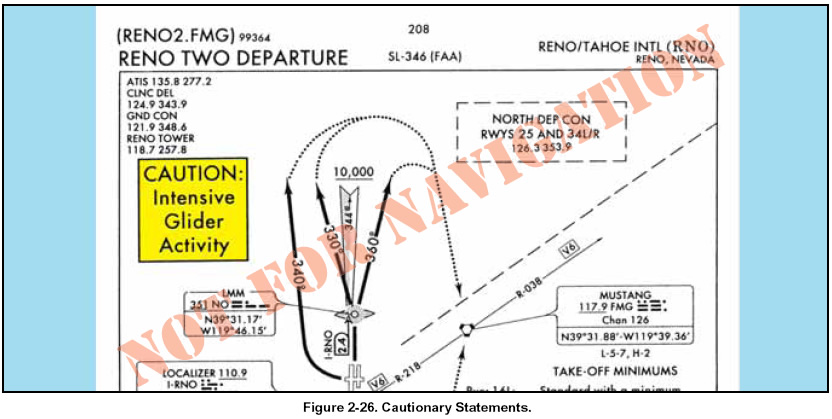 |
|
| INSTRUMENT PROCEDURES HANDBOOK |
|
FLIGHT PLANNING CONSIDERATIONS Take into consideration the departure paths included in the SIDs and determine if you can use a standardized departure procedure. You have the opportunity to choose the SID that best suits your flight plan. During the flight planning phase, you can investigate each departure and determine which procedure allows you to depart the airport in the direction of your intended flight. Also consider how a climb gradient to a specific altitude will affect the climb time and fuel burn portions of the flight plan. If ATC assigns you a SID, you may need to quickly recalculate your performance numbers. PROCEDURAL NOTES Another important consideration to make during your flight planning is whether or not you are able to fly your chosen departure procedure as charted. Notes giving procedural requirements are listed on the graphic portion of a departure procedure, and they are mandatory in nature. [Figure 2-25 on page 2-25] Mandatory procedural notes may include:
There are numerous procedural notes requiring specific compliance on your part. Carefully review the charts for the SID you have selected to ensure you can use the procedures. If you are unable to comply with a specific requirement, you must not file the procedure as part of your flight plan, and furthermore, you must not accept the procedure if ATC assigns it. Cautionary statements may also be included on the procedure to notify you of specific activity, but these are strictly advisory. [Figure 2-26 on page 2-26]
DP RESPONSIBILITY Responsibility for the safe execution of departure procedures rests on the shoulders of both ATC and the pilot. Without the interest and attention of both parties, the IFR system cannot work in harmony, and achievement of safety is impossible. ATC, in all forms, is responsible for issuing clearances appropriate to the operations being conducted, assigning altitudes for IFR flight above the minimum IFR altitudes for a specific area of controlled airspace, ensuring the pilot has acknowledged the clearance or instructions, and ensuring the correct read back of instructions. Specifically related to departures,ATC is responsible for specifying the direction of takeoff or initial heading when necessary, obtaining pilot concurrence that the procedure complies with local traffic patterns, terrain, and obstruction clearance, and including departure procedures as part of the ATC clearance when pilot compliance for separation is necessary. The pilot has a number of responsibilities when simply operating in conjunction with ATC or when using departure procedures under an IFR clearance:
When planning for a departure, pilots should:
By simply complying with departure procedures in their entirety as published, obstacle clearance is guaranteed. Depending on the type of departure used, responsibility for terrain clearance and traffic separation may be shared between pilots and controllers.
|
